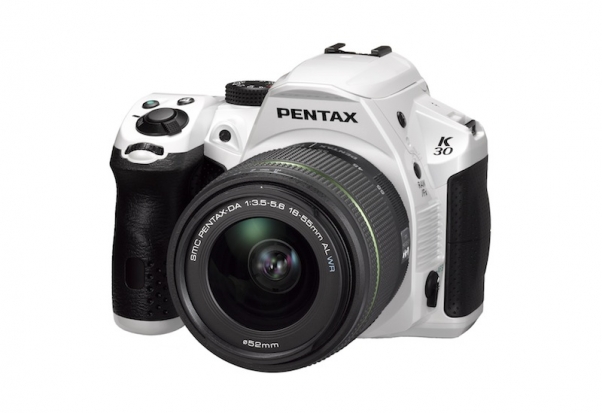
I spent two weeks with a white-bodied Pentax K-30 and its 18-55mm ƒ/3.5-5.6 kit lens. I took it around and about the villages where I'm currently living, into Cambridge for a day, to a craft evening, to my aunt's birthday dinner, and I conducted the necessary 'general fiddling' at home.
Basic spec
The Pentax K-30 has a 16.3 megapixel sensor coupled with a PRIME M engine. Sensitivity ranges from ISO 100 to 12,800, but this can be extended to 25,600. It has a maximum frames-per-second rate of six, if switch out of Raw and into JPEG mode. There's also full HD video with a choice of 24, 25, or 30 frames-per-second. It's also unusual amongst its fellow mid-range cameras with its weather sealing, allowing you to take it out in the cold, the wet, and the dusty.
At the moment you can pick up a K-30 with an 18-55mm kit lens for around £470 or just under $1,000. With the added seasonal cashback offer Pentax UK is running, this certainly makes the K-30 better value in the UK.
Build and handling
When I took the K-30 out of its box, my first impressions were of a solidily built camera with an interesting design. No, I wasn't quite convinced by the white body, but it does come in more sedate black as well as a bit more racy blue. The large, blocky, handgrip might not be to everyone's liking, but I found it very comfortable to hold. It is worth bearing in mind, however, that I'm not a big person at all and my hands are very small.
There were a few quirks of ergonomics that I did find irritating, however. The direction of the on/off switch felt counter-intuitive. It's a very minor thing and one that I'm sure I'd not think about twice with a little more use. The placement of the aperture control dial is a different matter, though. It was too far to the left for me to be able to use comfortably. Granted, this is something that's dependent on me and my anatomy, but it's still worthy of consideration.
I also found the shutter release button uncommonly sensitive. On more than a few occasions I took a photo when I was still adjusting the exposure or focusing. It's not a terrible fault, but something that I noticed.
As a general rule the menus were sensible and well laid-out. Every now and again, however, I'd be confronted with a situation where I simply couldn't find what I was looking for. Of course that's frustrating, but the more that you get to use something, the more familiar it becomes.
Performance
My first outing with K-30 was to my aunt's birthday dinner, held in a dimly-lit restaurant. I was very impressed with the colour reproduction and thought that it handled higher ISOs well, but I noticed what I think is probably the K-30's biggest downfall: its pitifully slow auto-focusing capability. I was disappointed when a good proportion of the photos weren't as crisp as I would have wanted them.
In good light, however, I had no complaints about the auto-focusing, and the auto white balance was pleasing, too. I'd be inclined to leave it on auto white balance, rather than fiddle about with the pre-sets.
I did notice a touch of under-exposure in images where there were particularly bright areas. (The photos taken at the river in Cambridge being a good example.) There is the Highlight and Shadow Correction option to help out here, and in these instances, the photos were easily corrected.
When it comes to ISO, you can use the K-30 comfortably up until ISO 1,600. You begin to notice degredation at ISO 3,200, but you could still get away with things here. I wouldn't push the ISO to the maximum 12,800 (expandable to 25,600) unless really necessary.
The K-30 comes with both Custom Image modes and digital filters. Having the two different settings to achieve a range of effects such as monochrome, toy camera, or bleach by-pass seems a bit kooky to me. Surely one function for these types of features is enough? However, I discovered to my cost that digital filters can't be applied to Raw images; there's no automatic 'Save Raw + JPEG' function. Yes, this is an oversight, but all of the effects can be achieved in post-processing if you really want them. So if you screw up, like I did, it isn't the end of the world!
The slow auto-focusing came back to haunt me when I tried to take some photos at a craft evening with my WI group (I took turning 30 very seriously, mmkay?). We meet in a hall with horrible lighting and the K-30 really struggled to pin-point its subject. It feels such a shame when it performs so well in other areas.
The verdict?
I really enjoyed using the K-30. I used it to take some great photos and thought it had some terrific features, especially that weather-proofing. I did feel let down by the slow auto-focusing, which really doesn't allow the camera to capitalise on its fantastic ISO performance. (I'm reliably informed that it does improve with the 18-135mm lens, but that adds to the price considerably when you're starting out.)
Would I buy it? Well, no. But that's because I'm already invested in another system and this isn't the camera I'm looking for.
Would I recommend it? At the moment, in the UK, the K-30 is cracking value for a mid-range dSLR with weather sealing. If you're looking for a decent SLR that will provide you with the opportunity to produce high quality pictures and a lot of fun, you should take a look.
There are more photos on my Flickr stream. You can take a look here.





